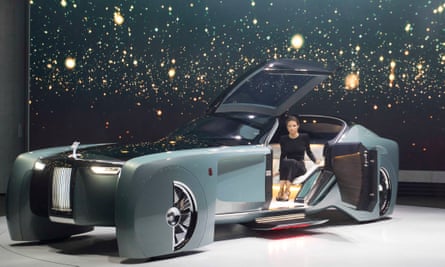Rolls-Royce has unveiled its first driverless vehicle, a concept car that promises to help its owner announce their importance to the world.
The Vision Next 100 is an autonomous vehicle aimed at “the most discerning and powerful patrons in the world”. It has no steering wheel and a silk “throne” from which its occupants can watch the world go by.
Rolls-Royce said the zero-emission model, codenamed 103EX, showed the company “rejects the notion of anonymous, utilitarian and bland future modes of mobility”.
In a statement that was short on technical specifications but packed with florid description, Rolls-Royce promised an interior made only of “the most precious and contemporary elegance”.
The owner will be “encircled by the most modern handcrafted fine-line Macassar wood panelling” as they gaze at a “generous” high-definition television screen.

Their comfort will be ensured not by an ordinary car seat, but by a “beautifully textured, ivory-coloured luxurious throne upon which our passengers are conveyed, and from which they command”.
Their feet will be cushioned by “the finest one-off deep-pile ivory wool carpet”, while anyone worried about leg room will be satisfied thanks to extra space afforded by “the removal of the chauffeur”.
Instead of a driver, passengers can give orders to a virtual assistant named Eleanor – after the actor Eleanor Thornton, who is rumoured to have inspired the car’s Spirit of Ecstasy bonnet ornament.
Eleanor will act as a concierge “imbued with her own artificial intelligence” and capable of reminding the owner not to miss meetings and even bringing the car around to the front of their house at the start of a journey.
Rolls-Royce, owned by BMW, said the car proved that “certain truths are constant over time”, such as the notion that “the powerful have always understood the symbols through which they express their standing”.

“The very size of the Rolls-Royce Vision Next 100 announces the importance of its precious cargo,” the carmaker explained, pointing to its vast dimensions – 5.9 metres long and 1.6 metres high.
The glass roof is a “canopy over the occupants that provides privacy while allowing them to contemplate the majesty of the stars in the firmament above as they glide through the night”.
The space usually reserved for the Rolls’ 12-cylinder engine will give way to a luggage compartment that opens automatically on arrival to present two personalised Grand Tourer cases.
And if the grandeur of the journey inside a vehicle that gives “the impression of a futuristic catamaran” was not enough, the car has something special in store on arrival at the passengers’ destination.

“As the Rolls-Royce Vision Next 100 gracefully comes to a halt, something magnificent occurs,” the company said. The glass roof rises to allow the occupant to stand, while a step emerges from below the running board and a red light is projected, “carpet-like” to announce their arrival.
“Thus, as in Botticelli’s ‘Birth of Venus’, our guest is framed and ready to step gracefully into the limelight and greet their audience … This is automotive haute couture,” the company added.
Amid the fanfare accompanying its unveiling, Rolls-Royce did not say how the vehicle, due to hit the streets in the 2040s, would be powered or how it would cope with speed bumps.
And despite the grand language, the concept car met with a mixed response, with technology website Slash Gear describing the vehicle as “sublimely crazy”.
This astonishing Rolls-Royce VISION NEXT 100 concept is sublimely crazy https://t.co/Q6f60E9dbB pic.twitter.com/oXvbz9bHeg
— SlashGear (@slashgear) June 16, 2016
Other car fans were even less sympathetic.
If this isn't a butt-ugly car, I don't know what is. Who cares if it's a Rolls-Royce? Models never good looking. pic.twitter.com/5xUwolHCSH
— AndThat'sTheWayItIs (@ABWright824) June 16, 2016
A number of companies are working on driverless cars, including Google. Its two-seater looks like a cross between a Smart Car and a Nissan Micra, has no steering wheel, accelerator or brakes, and just two physical controls: “stop” and “go”.
Nissan, Toyota, Audi and the ride-hailing service Uber are among those also working on a self-driving technology. Volvo intends to test them on London roads next year.
The Vision Next 100 – the brainchild of Giles Taylor, Rolls-Royce’s director of design – was unveiled at the Roundhouse arts venue in north London on Thursday.
“It is an expression of our intrinsic understanding of the possibilities for a true luxury brand and the desires of its customers,” Taylor said.

Comments (…)
Sign in or create your Guardian account to join the discussion